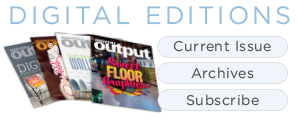By Lucy Feyrer
Part 1 of 2
Wide format—24 inches or wider—scanners are used in a number of environments for multiple reasons, whether it be for storage, archiving, or recreating a fine art print. Today’s wide format scanners are sometimes combined with a printer, creating a multifunction device. While scanning is still thought of as a hands-on process in many respects—especially in the fine art realm—mobile applications (apps) are affecting this technological process.
Mobile Control
Many of the newest releases on the AEC, GIS, and CAD side of wide format scanning include applications (apps) to remotely monitor projects and send scanned documents to contacts. Some of these scanners are standalone, while others are considered multifunction printers (MFPs).
For example, Colortrac’s three newest solutions—the SmartLF SG, SmartLF SC Xpress, and Professional MFP Solutions—are equipped with Colortrac FireFly communications technology. The technology incorporates a SuperSpeed USB 3.0 serial PC interface, which offers up to 85 MB/second transfer rate. This allows users to scan to cloud using storage services such as Apple iCloud, Dropbox, Google Drive, and Microsoft SkyDrive.
According to Marilu Sandoval, marketing manager, Paradigm Imaging Group, a distributor of Colortrac scanners, the benefits of FireFly technology include reduced data bottleneck, increased scanner productivity when handing a varied range of archive jobs, and the ability to scan higher resolution originals without reducing overall scan productivity.
All of Contex Americas’ IQ Quattro scanners, available in 24- to 44-inch widths, and its HD iFLEX flatbed scanner utilize the company’s mobile application—Pagedrop. Pagedrop is a downloadable app that allows users to connect smartphones or tablets to these specific Contex scanners.
Steve Blanken, GM, Contex Americas, believes that mobile apps are necessary and relevant to this type of scanner and the users it is designed for. “A big market for this is the construction industry, where scanners may reside in a construction project management trailer. There may be many users that need to use the scanner that don’t want to learn how to run it. Instead, they can use their smart device to operate the scanner by downloading an app,” he continues.
Mobility is important in the construction industry, agrees Alex Moñino, worldwide marketing director, Designjet large format printers, Hewlett-Packard (HP). “Documents need to be shared efficiently between stakeholders who could be in different locations, like in the field or office. Because of this need, scanners and MFPs need to be well integrated with an existing document management or cloud storage eco-system.”
The HP Designjet T2500 eMultifunction Printer series is equipped to send scanned documents to the HP Designjet ePrint & Share cloud service. HP Designjet ePrint & Share is available as a mobile app, which allows documents to be accessed, printed, and shared through the cloud. The MFPs are also integrated with Autodesk and American Reprographics’ mobile apps and document management services.
The Watchword
Mobility is certainly a buzzword being used more frequently in the graphic arts. It is currently finding success with AEC, GIS, and CAD verticals, namely those where not every member of an organization is based out of the same location. That said, vendors do foresee it making headway into other verticals in the future.
For example, Newly Corp.’s Scanera TopFace Pro is not currently equipped with any apps. “Even though we do not think a mobile app is necessary for our wide format scanner at this time, it will become more popular in the near future for graphics in advertisement,” admits Alex Kaneko, president, A-Lex International Consulting.
The second part of this series, covers all types of scanners—with and without mobility—with a roundup on some of the newest equipment.
![]()
Click on the link above to get more information on the vendors mentioned in this article.
Feb2015, Digital Output DOSC1502


